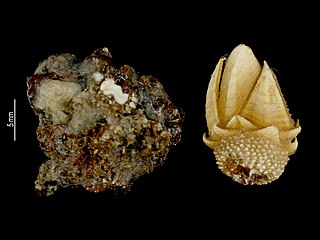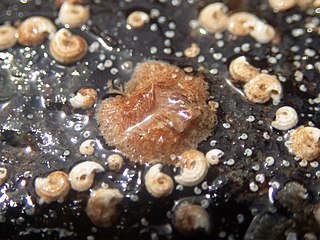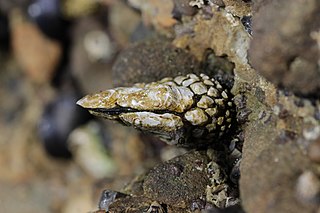
Thoracica is an infraclass of crustaceans which contains the most familiar species of barnacles found on rocky coasts, such as Semibalanus balanoides and Chthamalus stellatus. They have six well-developed limbs, and may be either stalked or sessile. The carapace is heavily calcified. The group includes free-living and commensal species.

Thecostraca is a class of marine invertebrates containing over 2,200 described species. Many species have planktonic larvae which become sessile or parasitic as adults.

Lepadidae is a family of goose barnacles, erected by Charles Darwin in 1852. There are about five genera and more than 20 described species in Lepadidae.

Calanticidae is a family of acorn barnacles in the order Calanticomorpha. There are about 12 genera and more than 60 described species in Calanticidae.

The Chthamaloidea are a subdivision of Balanomorpha proposed by Newman and Ross to include barnacles with shell wall composed of rostrum, carina, and one to three pairs of latera, rarely supplemented with one or more whorls of basal imbricating plates. The rostrolatus enters the sheath, but rarely fuses with the rostrum, as in the three higher superfamilies. Shell plates are simple in construction, solid, and incorporate organic chitin between carbonate layers. Opercular plates are deeply interlocked, and in some genera, may become concrescent with age. Soft part morphology includes concave labrum without notch in the central part. Cirrus III more resembles Cirrus IV than II, or may be intermediate in structure. Caudal appendages present in some species.
Pseudoctomeris sulcatus is a species of barnacle, the only member of the genus Pseudoctomeris. It has an eight-plated shell wall with the rostrum partially fused with adjacent rostrolatera. The suture lines are visible only from the inside, thus in exterior view, the shell appears to have six wall plates. The basis is calcareous. Opercular plates are higher than wide, and not deeply articulated. These features and others show strong relationship to family Pachylasmatidae, and taxonomic revision of Pachylasmatidae has resulted in the transfer of Pseudoctomeris from Chthamalidae to Pachylasmatidae.

Scalpellidae is a family of acorn barnacles in the order Scalpellomorpha. There are about 25 genera and 220 described species in Scalpellidae.

Verrucidae is a family of asymmetrical sessile barnacles in the order Verrucomorpha. There are about 14 genera and more than 90 described species in Verrucidae.
Cryptophialidae is a family of Acrothoracican barnacles in the order Cryptophialida, the sole family of the order. There are at least 2 genera and more than 20 described species in Cryptophialidae. These barnacles burrow into calcareous rocks and structures, such as limestone, shells, or corals.
Malacolepadidae is a family of acorn barnacles in the order Scalpellomorpha. There are at least two genera and two described species in Malacolepadidae.
Eolepadidae is an extinct family of barnacles in the order Eolepadomorpha. There are 2 genera and about 12 described species in Eolepadidae.

Brachylepadidae is an extinct family of barnacles in the order Brachylepadomorpha, the sole family in the order. There are about 7 genera and more than 20 described species in Brachylepadidae.

Calanticomorpha is an order of acorn barnacles in the class Thecostraca. There are 3 families and more than 90 described species in Calanticomorpha.

Pollicipedomorpha is an order of pedunculated barnacles in the class Thecostraca. There are 3 families and more than 30 described species in Pollicipedomorpha.

Microlasma is a genus of symmetrical sessile barnacles in the family Pachylasmatidae. There are at least four described species in Microlasma.

Eurylasma is a genus of symmetrical sessile barnacles in the family Pachylasmatidae. There are at least three described species in Eurylasma.

Eutomolasma is a genus of symmetrical sessile barnacles in the family Pachylasmatidae. There are at least four described species in Eutomolasma.

Metalasma is a genus of symmetrical sessile barnacles in the family Pachylasmatidae. There is one described species in Metalasma, M. crassum.

Pachylasma is a genus of symmetrical sessile barnacles in the family Pachylasmatidae. There are about eight described species in Pachylasma.

Tetrapachylasma is a genus of symmetrical sessile barnacles in the family Pachylasmatidae. There are about five described species in Tetrapachylasma.
















